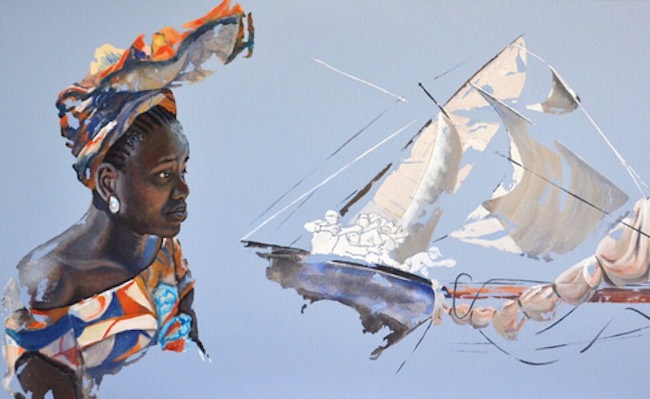I paesaggi marini costituiscono da sempre uno dei soggetti preferiti da artisti di ogni secolo e appartenenti a ogni movimento pittorico, perché il fascino dell’infinito, di una distesa d’acqua possente e ingovernabile o in altri casi tranquilla e rasserenante, è talmente magnetico da rendere impossibile anche ai grandi maestri di non misurarsi con questo tipo di soggetti. Impossibile è pensare al mare senza coinvolgere gli elementi che quotidianamente lo solcano facendone di fatto parte imprescindibile come le barche a vela, da sempre in grado di infondere nell’immaginario comune il senso del viaggio senza meta, la possibilità di realizzare il sogno che nella concretezza non è stato realizzato oppure, al contrario, rappresentano la fragilità della vita umana davanti alla grandezza della natura, l’impossibilità a volte di opporsi a correnti impetuose che sovrastano la forza di resistenza dell’uomo. Tutto questo è ciò che emerge dalle tele della protagonista di oggi.
Già nel Romanticismo Inglese il grande William Turner sottolineò la potenza delle acque in contrasto con la precarietà, la caducità dell’essere umano che era di fatto solo un piccolo dettaglio delle sue coinvolgenti tele, un punto insignificante nell’eternità dei paesaggi e del mondo che lo ospitava; tanto quanto La grande onda di Hokusai rappresentò per il Giappone un simbolo non solo della cultura della grande isola del Pacifico, bensì si legava alla filosofia tutta orientale del lasciarsi trasportare dagli eventi per permettergli di condurre l’uomo nel luogo migliore per sé. Nell’Impressionismo fu proprio una marina con la presenza di barche, sia a remi che a vela, a ispirare a Claude Monet a eseguire quell’opera, Impressioni al sol levante, che diede di fatto inizio al movimento stesso proprio per le piccole e brevi pennellate attraverso cui l’autore raccontò i riflessi delle acque all’alba, la calma del mare del primo mattino e la serenità di gesti ripetuti ogni giorno. Fu da fine Ottocento in avanti che la presenza di imbarcazioni, prevalentemente a vela, divenne più importante, predominante nei dipinti dei maestri che decisero di scegliere quel tema come quasi distintivo della loro produzione artistica; Paul Signac attraverso il suo Puntinismo diede la sua versione di porti e di paesaggi marini dove non poteva far mancare la presenza umana, e ancora l’Impressionismo dello spagnolo Joaquin Sorolla si concentrò prevalentemente su panorami di spiagge, di mari solcati da grandi vele sferzate dal vento forte dell’oceano. Persino uno dei maggiori esponenti del Realismo Americano, Edward Hopper, non sfuggì alla fascinazione del mare e delle imbarcazioni a vela dedicandogli la tela The Long Leg. Dunque, nella contemporaneità, l’artista di origine bulgare ma da anni naturalizzata italiana Diana Kirova si sente libera non solo di concentrare la sua attenzione creativa sulle vele, che costituiscono la parte più ampia della sua produzione artistica, bensì ne amplia il concetto attribuendo loro un significato simbolico che lega alle sensazioni provate nel percorso della sua esistenza, come se l’atto pittorico fosse catartico delle circostanze e degli accadimenti che man mano si susseguono.
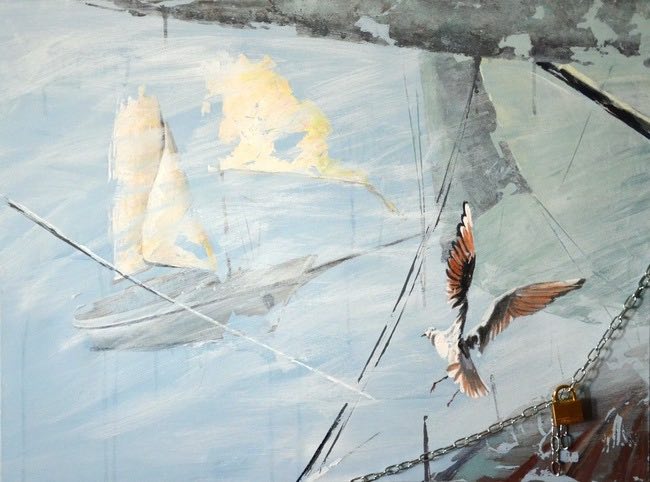
Il suo stile è a metà tra il Realismo e l’Espressionismo, anche se il tema della dissolvenza evoca quell’impossibilità di fermare il tempo e le emozioni che lascia affiorare un Simbolismo quasi metafisico, è in grado non solo di conquistare l’osservatore in virtù dei dettagli nitidi accompagnati poi dalla volatilità delle vele che sembrano costantemente essere trascinate via, frastagliate dalla brezza marina, ma anche di indurlo a perdersi dentro quell’alternanza di vuoti e pieni spesso funzionali a sottolineare un ricordo, un dettaglio che si allontana dal presente o di qualcuno che pur essendo stato importante per un lungo periodo ha poi terminato la fase di presenza nella vita dell’artista.
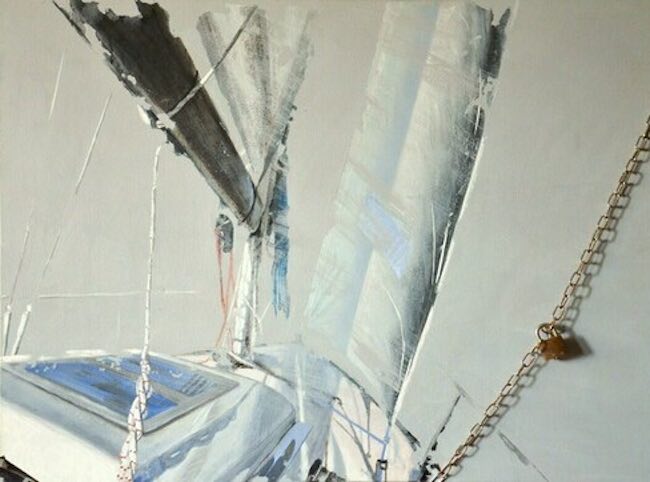
Di contro lo stesso fruitore non può fare a meno di sentirsi vicino nelle esperienze, notando quanto effettivamente alcuni episodi, alcuni individui, siano stati presenti per molto tempo pur costituendo un’esperienza più negativa che positiva, al punto che la scia del loro passaggio evapora molto più velocemente di quanto immaginato. Il mare per Diana Kirova rappresenta la libertà, quel desiderio di realizzare i propri sogni, i propri desideri troppo a lungo lasciati in secondo piano rispetto alla contingenza, ridimensionati da un intorno che sembrava volerle impedire di essere se stessa; attraverso la narrazione dell’acqua ma soprattutto delle imbarcazioni, è riuscita a infondere a se stessa il coraggio e la forza di oltrepassare gli ostacoli, di vincere contro le opposizioni e combattere per il suo obiettivo, quello di esprimere se stessa attraverso l’arte.
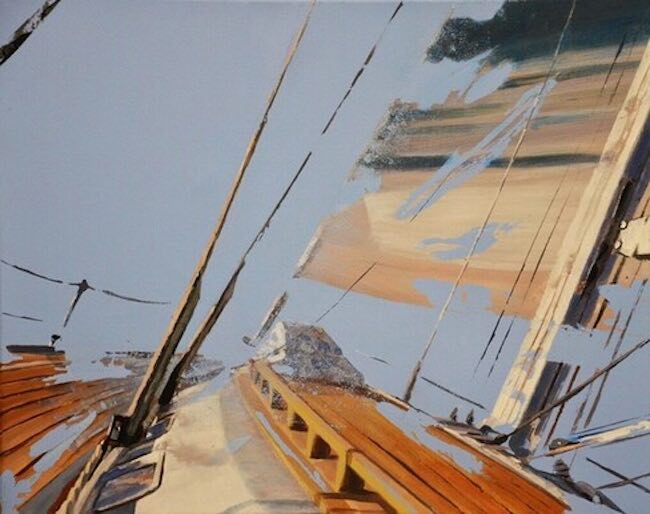
E proprio per la luce che la libertà infonde in lei, le sue opere sono luminose, avvolte da una luce chiara che diviene quasi impalpabile nel momento in cui affronta il tema interiore dell’allontanamento dalla realtà contingente, quella tendenza a elevarsi per percorrere il cammino che l’interiorità chiede; è questa la caratteristica della serie Fly, in cui la vela si stacca, vuole liberarsi dalle catene costituite dagli alberi della barca, metafora di tutti i limiti che spesso impediscono all’essere umano di spogliarsi dalle convenzioni, affrancarsi da quelle relazioni interpersonali che troppo spesso divengono una gabbia, una castrazione nei confronti della realizzazione personale. L’impalpabilità del sogno è rappresentata dalla nave in lontananza, sospesa tra cielo e mare, luogo quello dove tutto può diventare possibile, dove la realtà sembra più sopportabile e l’opzione di perseguire ciò che davvero si vuole sembra più concreta.
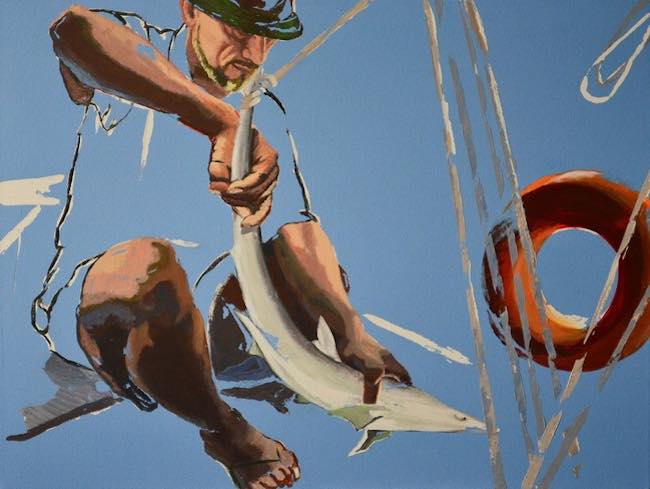
Nell’opera Ego invece i colori sono intensi, tanto quanto effimero è il corpo del protagonista che si sente pieno di sé, di sicurezza in se stesso ma che poi, a osservarlo con maggiore attenzione mostra il vuoto di una personalità senza empatia, senza capacità di ascolto, e così quell’essere tanto concentrato su se stesso diviene il motivo per cui l’essenza viene meno, non esiste, viene dissolta da Diana Kirova attraverso il non essere, un vuoto che lo mette in relazione con il mondo circostante ridimensionando dunque l’importanza che egli stesso tende a darsi. In qualche modo, ampliando il concetto, la tela può essere metafora dell’essere umano che dimentica di vivere in un mondo, quello naturale, che non dovrebbe mai essere trascurato o distrutto per permettergli di realizzare i suoi disegni senza prendere in considerazione che le sue azioni possano danneggiare l’ambiente, la vita, tutto ciò che esiste.
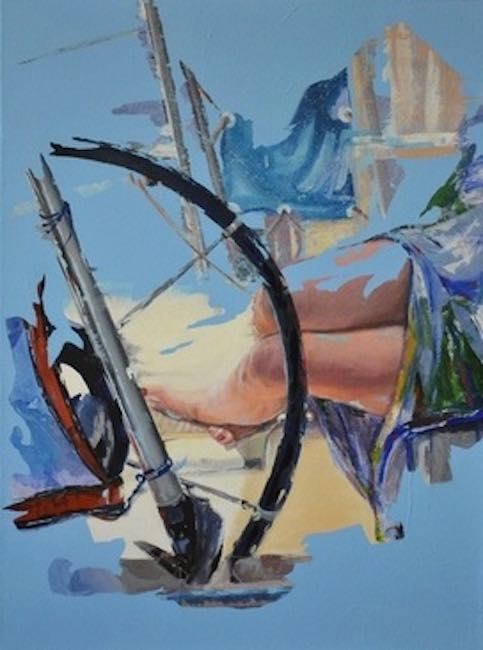
In Mare e sole, al contrario, le gambe appartenenti a una donna sembrano effettuare un percorso contrario rispetto all’opera precedente, perché piuttosto che dissolversi si concretizzano e si immergono in quel senso di libertà, finalmente realizzato, che solo nel mare può trovare consistenza e compimento; tutti i blocchi che avevano contraddistinto il passato vengono sfumati e trascinati via dal vento mentre il presente e ciò che lo costituisce è più definito, più preciso nella descrizione, e decisamente più luminoso come può esserlo il viaggio verso qualcosa che si è a lungo desiderato e poi scelto.
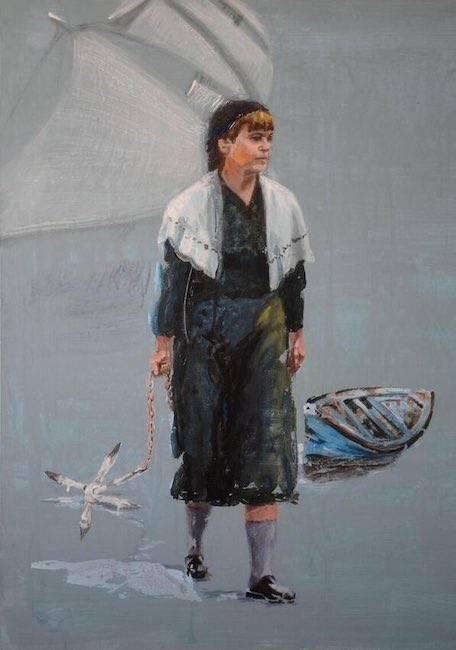
Ma la produzione pittorica di Diana Kirova non si limita alle marine bensì si estende anche al mondo subacqueo, agli scorci di luoghi visitati e amati in cui emerge la sua tendenza a concentrare l’attenzione pittorica su ciò che ha colpito il suo sguardo, un colore, un insieme, omettendo invece la precisione del resto, il contorno, ciò che nei paesaggi viene definito tanto quanto l’immagine principale; in lei al contrario tutto il resto si dissolve seguendo quel processo naturale della memoria in virtù del quale si mantiene viva l’immagine che più ha catturato lo sguardo, perché in fondo ciò che davvero conta è l’emozione che si è propagata dalla sensazione iniziale. Quando racconta invece delle persone, la Kirova tende a diventare metafisica, mette a fuoco il concetto che desidera esprimere, e che svela nei titoli delle tele, decontestualizzando i protagonisti, ponendoli al centro di un pensiero che si concretizza proprio attraverso la loro posizione, il loro essere nascosti oppure inconsapevolmente in primo piano di un pensiero che attraversa la mente dell’artista e che ha bisogno di essere espresso.
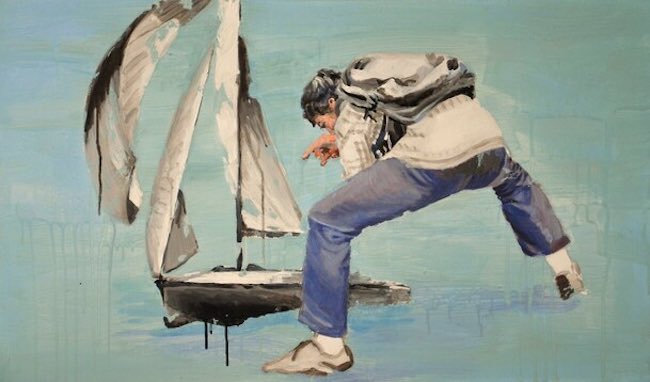
In To be infatti l’uomo si china minaccioso verso la barca a vela come volesse dettare prepotentemente le sue regole, senza rendersi conto che il vento non può avere leggi, tanto quanto chi riceve dettami prima o poi si sfila dall’egemonia e si lascia trascinare via per cercare la libertà mancata. Diana Kirova ha al suo attivo mostre personali a Roma, Punta Ala, Civitavecchia e a Oakville in Canada, e molte mostre collettive su tutto il territorio nazionale; è presente in diverse edizioni delle Fiere Vernice Art Fair di Forlì, Arte Padova, Arte Genova e Immagina Arte di Reggio Emila con la Neo Art Gallery. Dal 2008 espone con la storica Associazione Cento Pittori di via Margutta di cui, nel 2019, diviene associata.
DIANA KIROVA-CONTATTI
Email: dianakirova.info@gmail.com
Sito web: https://www.dianakirova.it/
Facebook: https://www.facebook.com/diana.kirova2
Instagram: https://www.instagram.com/dianakirovaart/
Diana Kirova, the sea as a symbol of life’s moments and concepts expressed whispering, with an Expressionism that verges on poetry
Seascapes have always been one of the favourite subjects of artists of every century and belonging to every pictorial movement, because the fascination of the infinite, of an expanse of water that is powerful and ungovernable or in other cases calm and soothing, is so magnetic that it is impossible for even the great masters not to measure themselves against this kind of subjects. It is impossible to think of the sea without involving the elements that cross it every day, making it an inescapable part of the world, such as sailboats, which have always been able to instil in the common imagination the sense of the aimless voyage, the possibility of realising the dream that in reality has not been realised, or, on the contrary, represent the fragility of human life before the greatness of nature, the impossibility at times of opposing impetuous currents that overwhelm man’s strength of resistance. All of this is what emerges from the canvases of today’s protagonist.
Already in English Romanticism, the great William Turner emphasised the power of the waters in contrast with the precariousness, the caducity of the human being, who was in fact only a small detail in his enthralling canvases, an insignificant point in the eternity of the landscapes and the world that hosted him; just as Hokusai‘s The Great Wave represented for Japan a symbol not only of the culture of the great Pacific island, but was linked to the all-Oriental philosophy of letting oneself be carried by events to allow them to lead man to the best place for himself. In Impressionism, it was a marina with the presence of boats, both rowing and sailing, that inspired Claude Monet to execute that artwork, Impressions of the Rising Sun, which in fact initiated the movement itself precisely because of the small, short brushstrokes through which the author depicted the reflections of the waters at dawn, the calm of the sea in the early morning and the serenity of gestures repeated every day. It was from the end of the 19th century onwards that the presence of boats, mainly sailing boats, became more important, predominant in the paintings of the masters who decided to choose that theme as an almost distinctive feature of their artistic production; Paul Signac through his Pointillism gave his version of ports and seascapes where the human presence could not be absent, and again the Impressionism of the Spanish Joaquin Sorolla concentrated mainly on views of beaches, of seas furrowed by large sails whipped by the strong wind of the ocean. Even one of the greatest exponents of American Realism, Edward Hopper, did not escape the fascination of the sea and sailing boats, dedicating to him the canvas The Long Leg.
Therefore, in contemporary times, the artist of Bulgarian origin but for years now naturalised as an Italian, Diana Kirova, feels free not only to focus her creative attention on sails, which make up the largest part of her artistic production, but she broadens the concept by attributing to them a symbolic meaning that links them to the sensations she has experienced along the path of her existence, as if the act of painting were cathartic of the circumstances and events that gradually follow one another. Her style is somewhere between Realism and Expressionism, even if the theme of fading evokes that impossibility of stopping time and emotions that allows an almost metaphysical Symbolism to emerge, it is able not only to captivate the observer by virtue of the sharp details accompanied by the volatility of the sails that seem to be constantly being swept away, jagged by the sea breeze, but also induces the viewer to lose himself within that alternation of empty and full spaces often functional to emphasise a memory, a detail that recedes from the present or of someone who, despite having been important for a long period of time, has then ended his presence in the artist’s life. On the other hand, the viewer himself cannot help but feel close to the experiences, noting how effectively certain episodes, certain individuals, have been present for a long time despite constituting a more negative than positive experience, to the point that the wake of their passage evaporates much faster than imagined.
For Diana Kirova, the sea represents freedom, that desire to realise one’s dreams, one’s desires that have for too long been left in the background compared to contingency, scaled down by an environment that seemed to want to prevent her from being herself; through the narrative of water, but above all of boats, she has succeeded in instilling in herself the courage and strength to overcome obstacles, to win over opposition and fight for her goal, that of expressing herself through art. And it is precisely because of the light that freedom instils in her that her paintings are luminous, enveloped in a clear light that becomes almost impalpable when she addresses the inner theme of detachment from contingent reality, that tendency to elevate oneself in order to follow the path that interiority demands; this is the characteristic of the series Fly, in which the sail detaches itself, wants to free itself from the chains formed by the masts of the boat, a metaphor for all the limits that often prevent human beings from stripping of conventions, freeing from those interpersonal relationships that all too often become a cage, a castration towards personal fulfilment. The intangibility of the dream is represented by the ship in the distance, suspended between sky and sea, the place where everything can become possible, where reality seems more bearable and the option of pursuing what one really wants seems more concrete. In the artwork Ego, on the other hand, the colours are intense, as ephemeral as the body of the protagonist who feels full of himself, of self-confidence, but then, when observed more closely, shows the emptiness of a personality without empathy, without the ability to listen, and so that being so concentrated on himself becomes the reason why the essence is lost, it does not exist, it is dissolved by Diana Kirova through non-being, a void that puts him in relation to the world around him, thus resizing the importance that he tends to give himself. In some ways, broadening the concept, the canvas can be a metaphor for the human being who forgets that he lives in a world, the natural one, which should never be neglected or destroyed in order to allow him to realise his designs without taking into consideration that his actions may damage the environment, life, everything that exists.
In Sea and Sun, on the contrary, the legs belonging to a woman seem to take an opposite route to the previous work, because rather than dissolving, they materialise and immerse themselves in that sense of freedom, finally realised, which only in the sea can find consistency and fulfilment; all the blocks that had characterised the past are blurred and dragged away by the wind while the present and what constitutes it is more defined, more precise in its description, and decidedly more luminous as the journey towards something that one has long desired and then chosen can be. However, Diana Kirova‘s painting production is not limited to seascapes, but also extends to the underwater world, to glimpses of places she has visited and loved, in which emerges her tendency to focus her painterly attention on what has caught her eye, a colour, an ensemble, omitting instead the precision of the rest, the outline, what in landscapes is defined as much as the main image; in her, on the contrary, everything else dissolves following that natural process of memory by virtue of which the image that has most caught the eye is kept alive, because in the end what really counts is the emotion that has spread from the initial sensation. When, on the other hand, she tells about people, Kirova tends to become metaphysical, focusing on the concept she wishes to express, and which she reveals in the titles of the canvases, decontextualising the protagonists, placing them at the centre of a thought that is realised precisely through their position, their being hidden or unconsciously in the foreground of a thought that runs through the artist’s mind and needs to be expressed.
In To be, in fact, the man leans menacingly towards the sailboat as if he wanted to overbearingly dictate his rules, without realising that the wind cannot have laws, just as those who receive dictates sooner or later break away from the hegemony and allow themselves to be swept away in search of missed freedom. Diana Kirova has to her credit solo exhibitions in Rome, Punta Ala, Civitavecchia and Oakville in Canada, and many group exhibitions throughout Italy; she is present in various editions of the Vernice Art Fair in Forlì, Arte Padova, Arte Genova and Immagina Arte in Reggio Emila with the Neo Art Gallery. Since 2008 she has been exhibiting with the historical Associatione Cento Pittori di via Margutta of which, in 2019, she became a member.


